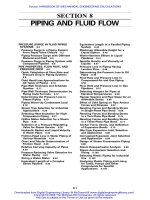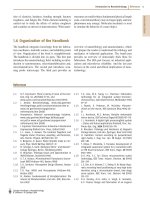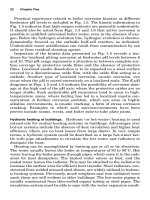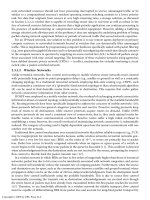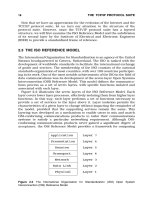Tài liệu Handbook of Sensor Networks P2 doc
Bạn đang xem bản rút gọn của tài liệu. Xem và tải ngay bản đầy đủ của tài liệu tại đây (682.59 KB, 10 trang )
Next-Generation Technologies to Enable Sensor Networks
2
-7
onto networked resources should not have processing interrupted to service unmanaged traffic or be
subject to a computational resource’s resident operating system switching contexts to a lower priority
task. For data that originate from sensors at very high streaming rates, a storage solution, as discussed
in Section 2.3.2, is needed that is capable of recording sensor data in real time as well as robust in the
face of network resource failures; this insures that a high-priority application can continue processing in
the presence of malfunctioning or compromised networked equipment. However, adding a buffering
storage solution only alleviates part of the problem; it does not mitigate the underlying problem of losing
packets during network equipment failures or periods of network traffic that exceed network capacities.
For an IP-based network, one solution to this problem is to use remote agents deployed on primary
compute resources or networked terminals located at switches that can dynamically filter unmanaged
traffic. This is implemented by programming computer hardware specifically tasked with packet filtering
(e.g., next generation gigabit Ethernet card) or dynamically reconfiguring the switch that directly connects
to the compute resource in question by supplying an access control list (ACL) to block all packets except
those associated with time-critical targeting. The formation of these exclusive networks using agents has
been dubbed
dynamic private networks
(DPNs) — in effect, mechanisms for virtually overlaying a circuit
switch onto a packet-switched network.
2.3.1.2 Wireless Networks
Unlike terrestrial networks, flow control and routing in mobile wireless sensor networks must contend
with potentially long point-to-point propagation delays (e.g., satellite to ground) as well as a constantly
changing topology. In a traditional terrestrial network employing link-state routing (e.g., OSPF), each
node maintains a consistent view of a (primarily) fixed network topology so that a shortest path algorithm
[8] can be used to find desirable routes from source to destination. This requires that nodes gather
network connectivity information from other routers.
If OSPF were employed in a mobile wireless network, the overhead of exchanging network connectivity
information about a transient topology could potentially consume the majority of the available bandwidth
[9]. Routing protocols have been specifically designed to address the concerns of mobile networks [10];
these protocols fall into two general categories: proactive and reactive. Proactive routing protocols keep
track of routes to all destinations, while reactive protocols acquire routes on demand. Unlike OSPF,
proactive protocols do not need a consistent view of connectivity; that is, they trade optimal routes for
feasible routes to reduce communication overhead. Reactive routes suffer a high initial overhead in
establishing a route; however, the overall overhead of maintaining network connectivity is substantially
reduced. The category of routing used is highly dependent upon how the sensors communicate with one
another over the network.
Traditional flow control mechanisms over terrestrial networks that deliver reliable transport (e.g., TCP)
may be inappropriate for wireless networks because, unlike wireless networks, terrestrial networks gen-
erally have a very low bit error rate (BER) on the order of 10
–10
, so errors are primarily due to packet
loss. Packet loss occurs in heavily congested networks when an ingress or egress queue of a switch or
router begins to fill, requiring that some packets in the queue be discarded [11]. This condition is detected
when acknowledgments from the destination node are not received by the source, prompting the source’s
flow control to throttle back the packet transmit rate [12].
In a wireless network in which BERs are four to five orders of magnitude higher than those of terrestrial
networks, packet loss due to bit errors can be mistakenly associated with network congestion, and source
flow control will mistakenly reduce the transmit rate of outgoing packets. Furthermore, when the source
and destination are far apart, such as the communication between a satellite and ground terminal, where
propagation delays can be on the order of 240 ms, delayed acknowledgments from the destination result
in source flow control inefficiently using the available bandwidth. This is due to source flow control
incrementally increasing the transmit rate as destination acknowledgements are received even though
the entire frame of packets may have already been transmitted before the first packet reaches the receiver
[13]. Therefore, to use bandwidth efficiently in a wireless network for reliable transport, flow control
must be capable of differentiating BER from packet loss and account for long-haul packet transport by
1968_C02.fm Page 7 Monday, June 14, 2004 2:35 PM
Copyright © 2005 by CRC Press LLC
2
-8
Handbook of Sensor Networks
more efficiently using the available bandwidth. Some work in this area is reflected in RFC 2488 [14], as
well as proposals for an explicit congestion warning, where, for example, the destination site would
respond to packet errors with an acknowledgment that it received the source packets with a corruption
notification.
At the physical layer, high data rates for a given BER have been realized by employing low-density
parity check codes, such as turbo codes, in conjunction with bandwidth efficient modulation to achieve
spectral efficiencies to within 0.7 dB of the Shannon limit [15]. Furthermore, extremely high spectral
efficiencies have been demonstrated using multiple input, multiple output (MIMO) antenna systems
whose theoretical channel capacity increases linearly with the number of transmit/receive antenna pairs
[16]. Although turbo codes are advantageous as a forward error correction mechanism in wireless systems
when trying to maximize throughput, MIMO systems achieve high spectral efficiencies only when
operating in rich scattering environments [17]. In environments in which little scattering occurs, such
as in some air-to-air communication links, MIMO systems offer very little improvement in spectral
efficiency.
2.3.2 Guaranteeing Storage Buffer Resources
For a variety of reasons, it may be very desirable to record streaming sensor data directly to storage media
while simultaneously sending the data on for immediate processing. For sensor signal processing appli-
cations, this enables multimodality data fusion of archived data with real-time (perishable) data from
in-theatre sensors for improved target identification and visualization [18]. Storage media could also be
used for rate conversion in cases in which the transmission rate exceeds the processing rate and for time-
delay buffering for real-time robust fault tolerance (discussed in the next section). The storage media
buffer reuse is deterministic and periodic so that management of the buffer is straightforward.
A number of possible solutions exist:
•
Directly attached storage
is a set of hard disks connected to a computer via SCSI or IDE/EIDE/
ATA; however, this technology does not scale well to the volume of streaming sensor data.
•
Storage area networks
are hard disk storage cabinets attached to a computer with a fast data link
like Fibre Channel. The computer attached to the storage cabinet enjoys very fast access to data,
but because the data must travel through that computer, which presents a single point of failure,
to get to other computers on the network, this option is not a desirable solution.
•
Network-attached storage
connects the hard disk storage cabinet directly to the network as a file
server. However, this technology offers only midrange performance, a single point of failure, and
relatively high cost.
A visionary architecture in which data storage centers operate in parallel at a wide-area network (WAN)
and local area network (LAN) level is described in Cooley et al. [19]. In this architecture, developed by
MIT Lincoln Laboratory, high-rate streaming sensor data are stored in parallel across a partitioned
network of storage arrays, which affords a highly scalable, low-cost solution that is relatively insensitive
to communications or storage equipment failure. This system employs a novel and computationally
efficient encoding and decoding algorithm using low-density parity check codes [20] for erasure recovery.
Initial system performance measures indicate the erasure coding method described in Cooley et al. [19]
has a significantly higher throughput and greater reliability when compared to Reed–Solomon, Tornado
[21], and Luby [20] codes. This system offers a promising low-cost solution that scales in capability with
the performance gains of commodity equipment.
2.3.3 Guaranteeing Computational Resources
The exponential growth in computing technology has contributed to making viable the implementation
of advanced sensor processing in cost-effective hardware with form factors commensurate with the needs
of military users. For example, several generations of embedded signal processors are shown in Figure 2.5.
1968_C02.fm Page 8 Monday, June 14, 2004 2:35 PM
Copyright © 2005 by CRC Press LLC
Next-Generation Technologies to Enable Sensor Networks
2
-9
In the early 1990s, embedded signal processors were built using custom hardware and software. In the late
1990s, a move occurred from custom hardware to COTS processor systems running vendor-specific
software together with application-specific parallel software tuned to each specific application. Most
recently, the military embedded community is beginning to demonstrate requisite performance employing
parallel and portable software running on COTS hardware.
Continuing technology advances in computation and communication will permit future signal pro-
cessors to be built from commodity hardware distributed across a high-speed network and employing
distributed, parallel, and portable software. These computing architectures will deliver 10
9
to 10
12
floating
point operations per second (GFLOPs to TFLOPs) in computational throughput. The distributed nature
of the software will apply to on-board sensor processing as well as off-board processing. Clearly, on-
board embedded processor systems will need to meet the stringent platform requirements in size, weight,
and power.
Wireless and terrestrial network resources are not the only areas in which delays, failures, and errors
must be avoided to process sensor data in a timely fashion. The system design must also guarantee that
the marshaled compute nodes will keep up with the required computational throughput of streaming
data at every stage of the processing chain. This guarantee encompasses two important facets: (1) keeping
the processors from being interrupted while they are processing tasks and (2) implementing fail-over
that is tolerant of fault.
2.3.3.1 Avoiding Processor Interruption
It is easy to take for granted that laptop and desktop computers will process commands as fast as the
hardware and software are capable of doing so. A fact not generally known is that general computers are
interrupted by system task processes and the processes of other applications (one’s own and possibly
from others working in the background on one’s system). System task processes include keyboard and
mouse input; communications on the Ethernet; system I/O; file system maintenance; log file entries; etc.
When the computer interrupts an application to attend to such tasks, the execution of the application is
temporarily suspended until the interrupting task has finished execution. However, because such inter-
ruptions often only consume a few milliseconds of processing time, they are virtually imperceptible to
the user [22].
Nevertheless, the interruptions are detrimental to the execution of real-time applications. Any delay
in processing these streams of data will instigate a need for buffering the data that will grow to insur-
mountable size as the delays escalate. A solution for these interrupt issues is to use a real-time operating
system on the computation processors.
FIGURE 2.5
Embedded signal processor evolution.
85 GFLOPS
COTS Parallel SW
Adaptive Processor
Gen 1 (1992)
22 GOPS
Custom (Parallel) SW
Adaptive Processor
Gen 2 (1998)
AEGIS & Standard Missile
Test Beds (2000+)
PTCN Network
Test Bed (2002+)
VME Backplane
Custom Boards
RACE Crossbar
Multi-chassis COTS
50+ GFLOPS
Portable, Parallel SW
(VSIPL, MPI, & PVL)
High Speed LANs
Network of Workstations
GFLOPS to TFLOPS
Parallel & Distributed SW
(PVL & CORBA)
High Speed LANs & WANs
Networked Clusters, Servers
Distributed
Network
1968_C02.fm Page 9 Monday, June 14, 2004 2:35 PM
Copyright © 2005 by CRC Press LLC
2
-10
Handbook of Sensor Networks
Simply put, real-time operating systems (RTOS) give priority to computational tasks. They usually do
not offer as many operating system features (virtual memory, threaded processing, etc.) because of the
interrupting processing nature of these features [22]. However, an RTOS can ensure that real-time critical
tasks have guaranteed success in meeting streamed processing deadlines. An RTOS does not need to be
run on typical embedded processors; it can also be deployed on Intel and AMD Pentium-class or Motorola
G-series processor systems. This includes Beowulf clusters of standard desktop personal computers and
commodity servers. This is an important benefit, providing a wide range of candidate heterogeneous
computing resources.
A great deal of press has been generated in the past several years about real-time operating systems;
however, the distinction between soft real-time and hard real-time operating systems is seldom discussed.
Hard real-time systems guarantee the completion of tasks in a deterministic time period, while soft real-
time systems give priority to critical tasks over other tasks but do not guarantee the completion of tasks
in a deterministic time period [22]. Examples of hard real-time operating systems are VxWorks (Wind
River Systems, Inc. [23]); RTLinux/Pro (FSMLabs, Inc. [24]); and pSOS (Wind River Systems, Inc. [23]),
as well as dedicated massively parallel embedded operating systems like MC/OS (Mercury Computer
Systems, Inc. [25]). Examples of soft real-time operating systems are Microsoft Pocket PC; Palm OS;
certain real-time Linux releases [24, 26]; and others.
2.3.3.2 Working through System Faults
When fault tolerance in massively parallel computers is addressed, usually the solution is parallel redun-
dant systems for fail-over. If a power supply or fan fails, another power supply or fan that is redundant
in the system takes over the workload of the failed device. If a hard disk drive fails on a redundant array
of independent disks (RAID) system, it can be hot swapped with a new drive and the contents of the
drive rebuilt from the contents of the other drives along with checksum error correction code information.
However, if an individual processor fails on a parallel computer, it is considered a failure of the entire
parallel computer, and an identical backup computer is used as a fail-over. This backup system is then
used as the primary computer, while the failed parallel computer is repaired to become the backup for
the new primary eventually.
If, however, it were possible to isolate the failed processor and remap and rebind the processes on
other processors in that computer — in real time — it would then be possible to have only a number
of redundant processors in the system rather than entire redundant parallel computers. There are two
strategies for determining the remapping as well as two strategies for handling the remapping and
rebinding; each has its advantages and disadvantages.
To discuss these fail-over strategies, it is necessary to define the concepts of tasks and mappings. A signal
processing application can be separated into a series of pipelined stages or tasks that are executed as part
of the given application. A mapping is the task-parallel assignment of a task to a set of computer and network
resources. In terms of determining the fail-over remapping, it is possible to choose a single remapping for
each task or to choose a completely unique secondary path — a new mapping for each task that uses a set
of processors mutually exclusive from the processors in the primary mapping path. If task backup mappings
are chosen for each task, the fail-over will complete faster than a full processing chain fail-over; however,
the rebinding fail-over for a failed task mapping is more difficult because the mappings from the task before
and the task after the failed task mapping must be reconfigured to send data to and receive data from the
new mapping. Conversely, if a completely unique secondary path is chosen as a fail-over, then fail-over
completion will have a longer latency than performing a single task fail-over. However, the fail-over mechan-
ics are simpler because the completely unique secondary path could be fully initialized and ready to receive
the stream of data in the event of a failure in the primary mapping path.
In terms of handling the remapping and rebinding of tasks, it is possible to choose the fail-over
mappings when the application is initially launched or immediately after a fault occurs. In either case,
greater latency is incurred at launch time or after the occurrence of a fault. For these advanced options,
support for this fault tolerance comes mainly from the middleware support, which is discussed in the
next section, and from the NRM discussed in Section 2.5.
1968_C02.fm Page 10 Monday, June 14, 2004 2:35 PM
Copyright © 2005 by CRC Press LLC
Next-Generation Technologies to Enable Sensor Networks
2
-11
2.4 Middleware
Middleware not only provides a standard interface for communications between network resources and
sensors for plug-and-play operation, but also enables the rapid implementation of high-performance
embedded signal processing.
2.4.1 Control and Command of System
Because many systems use a diverse set of hardware, operating systems, programming languages, and
communication protocols for processing sensor data, the manpower and time-to-deployment associated
with integration have a significant cost. A middleware component providing a uniform interface that
abstracts the lower-level system implementation details from the application interface is the common
object request broker architecture (CORBA) [27]. CORBA is a specification and implementation that
defines a standard interface between a client and server. CORBA leverages an interface definition language
(IDL) that can be compiled and linked with an object’s implementation and its clients. Thus, the CORBA
standard enables client and server communications that are independent of the host hardware platforms,
programming language, operating systems, and so on. CORBA has specifications and implementations
to interface with popular communication protocols such as TCP/IP. However, this architecture has an
open specification, general interORB protocol (GIOP) that enables developers to define and plug in
platform-specific communication protocols for unique hardware and software interfaces that meet appli-
cation-specific performance criteria.
For real-time and parallel embedded computing, it is necessary to interface with real-time operating
systems, define end-to-end QoS parameters, and enact efficient data reorganization and queuing at
communication interfaces. CORBA has recently included specifications for real-time performance and
parallel processing, with the expectation that emerging implementations and specification addendums
will produce efficient implementations. This will enable CORBA to move out of the command and
control domain and be included as a middleware component involved in real-time and parallel processing
of time-critical sensor data.
2.4.2 Parallel Processing
The ability to choose one of many potential parallel configurations enables numerous applications to
share the same set of resources with various performance requirements. What is needed is a method to
decouple the mapping, that is, the parallel instantiation of an application on target hardware, from generic
serial application development. Automating the mapping process is the only feasible way of exploring
the large parameter space of parallel configurations in a timely and cost-effective manner.
MIT Lincoln Laboratory has developed a C++-based library known as the parallel vector library (PVL)
[28]. This library contains objects with parameterized methods deeply rooted in linear algebraic expres-
sions commonly found in sensor signal processing. The parameters are used to direct the object instance
to process data as one constituent part of a parallel whole. The parameters that organize objects in parallel
configurations are run-time parameters so that new parallel configurations can be instantiated without
having to recompile a suite of software. The technology of PVL is currently being incorporated into the
parallel vector, signal, and image processing library for C++ (parallel VSIPL++) standard library [29].
2.5 Network Resource Management
Given the stated goals for distributed network computing for sensor fusion as outlined in Section 2.3,
the associated network communication, storage, and processing challenges in Section 2.3, and the desire
for standard interfaces and libraries to enable application parallelism and plug-and-play integration in
Section 2.4, an integrated solution is needed that bridges network communications, distributed storage,
distributed processing, and middleware. Clearly, it is possible for a development team to implement a
1968_C02.fm Page 11 Monday, June 14, 2004 2:35 PM
Copyright © 2005 by CRC Press LLC

